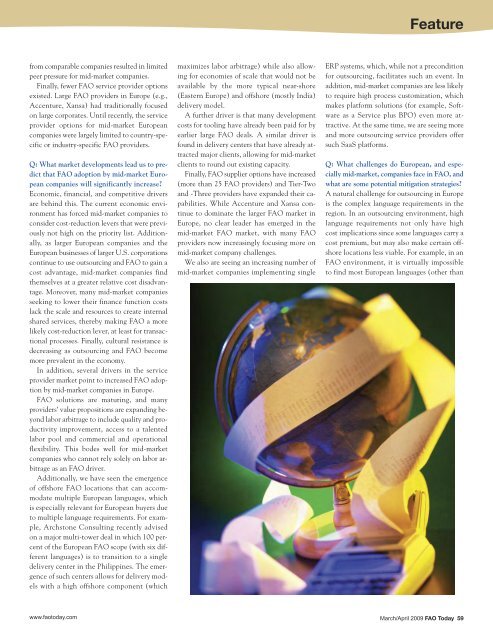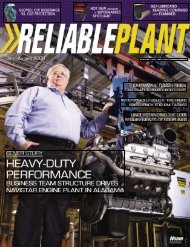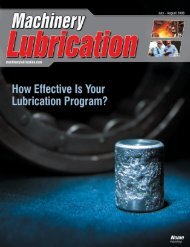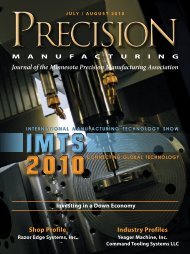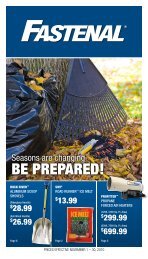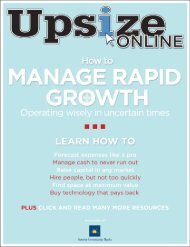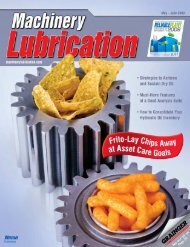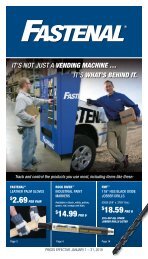March/April 2009 www.FAOToday.com
March/April 2009 www.FAOToday.com
March/April 2009 www.FAOToday.com
You also want an ePaper? Increase the reach of your titles
YUMPU automatically turns print PDFs into web optimized ePapers that Google loves.
Feature<br />
from <strong>com</strong>parable <strong>com</strong>panies resulted in limited<br />
peer pressure for mid-market <strong>com</strong>panies.<br />
Finally, fewer FAO service provider options<br />
existed. Large FAO providers in Europe (e.g.,<br />
Accenture, Xansa) had traditionally focused<br />
on large corporates. Until recently, the service<br />
provider options for mid-market European<br />
<strong>com</strong>panies were largely limited to country-specific<br />
or industry-specific FAO providers.<br />
Q: What market developments lead us to predict<br />
that FAO adoption by mid-market European<br />
<strong>com</strong>panies will significantly increase?<br />
Economic, financial, and <strong>com</strong>petitive drivers<br />
are behind this. The current economic environment<br />
has forced mid-market <strong>com</strong>panies to<br />
consider cost-reduction levers that were previously<br />
not high on the priority list. Additionally,<br />
as larger European <strong>com</strong>panies and the<br />
European businesses of larger U.S. corporations<br />
continue to use outsourcing and FAO to gain a<br />
cost advantage, mid-market <strong>com</strong>panies find<br />
themselves at a greater relative cost disadvantage.<br />
Moreover, many mid-market <strong>com</strong>panies<br />
seeking to lower their finance function costs<br />
lack the scale and resources to create internal<br />
shared services, thereby making FAO a more<br />
likely cost-reduction lever, at least for transactional<br />
processes. Finally, cultural resistance is<br />
decreasing as outsourcing and FAO be<strong>com</strong>e<br />
more prevalent in the economy.<br />
In addition, several drivers in the service<br />
provider market point to increased FAO adoption<br />
by mid-market <strong>com</strong>panies in Europe.<br />
FAO solutions are maturing, and many<br />
providers’ value propositions are expanding beyond<br />
labor arbitrage to include quality and productivity<br />
improvement, access to a talented<br />
labor pool and <strong>com</strong>mercial and operational<br />
flexibility. This bodes well for mid-market<br />
<strong>com</strong>panies who cannot rely solely on labor arbitrage<br />
as an FAO driver.<br />
Additionally, we have seen the emergence<br />
of offshore FAO locations that can ac<strong>com</strong>modate<br />
multiple European languages, which<br />
is especially relevant for European buyers due<br />
to multiple language requirements. For example,<br />
Archstone Consulting recently advised<br />
on a major multi-tower deal in which 100 percent<br />
of the European FAO scope (with six different<br />
languages) is to transition to a single<br />
delivery center in the Philippines. The emergence<br />
of such centers allows for delivery models<br />
with a high offshore <strong>com</strong>ponent (which<br />
maximizes labor arbitrage) while also allowing<br />
for economies of scale that would not be<br />
available by the more typical near-shore<br />
(Eastern Europe) and offshore (mostly India)<br />
delivery model.<br />
A further driver is that many development<br />
costs for tooling have already been paid for by<br />
earlier large FAO deals. A similar driver is<br />
found in delivery centers that have already attracted<br />
major clients, allowing for mid-market<br />
clients to round out existing capacity.<br />
Finally, FAO supplier options have increased<br />
(more than 25 FAO providers) and Tier-Two<br />
and -Three providers have expanded their capabilities.<br />
While Accenture and Xansa continue<br />
to dominate the larger FAO market in<br />
Europe, no clear leader has emerged in the<br />
mid-market FAO market, with many FAO<br />
providers now increasingly focusing more on<br />
mid-market <strong>com</strong>pany challenges.<br />
We also are seeing an increasing number of<br />
mid-market <strong>com</strong>panies implementing single<br />
ERP systems, which, while not a precondition<br />
for outsourcing, facilitates such an event. In<br />
addition, mid-market <strong>com</strong>panies are less likely<br />
to require high process customization, which<br />
makes platform solutions (for example, Software<br />
as a Service plus BPO) even more attractive.<br />
At the same time, we are seeing more<br />
and more outsourcing service providers offer<br />
such SaaS platforms.<br />
Q: What challenges do European, and especially<br />
mid-market, <strong>com</strong>panies face in FAO, and<br />
what are some potential mitigation strategies?<br />
A natural challenge for outsourcing in Europe<br />
is the <strong>com</strong>plex language requirements in the<br />
region. In an outsourcing environment, high<br />
language requirements not only have high<br />
cost implications since some languages carry a<br />
cost premium, but may also make certain offshore<br />
locations less viable. For example, in an<br />
FAO environment, it is virtually impossible<br />
to find most European languages (other than<br />
<strong>www</strong>.faotoday.<strong>com</strong><br />
<strong>March</strong>/<strong>April</strong> <strong>2009</strong> FAO Today 59


